Did you know that the bats flying above you at dusk are shouting as loud as a fire alarm in your ear but you can’t hear them? That’s because they’re calling in frequencies that are too high for your ears to detect. But now, with an incredible little bat detector that plugs into your phone, along with a bat detector app, you can hear bat echolocations in real time, record them, and identify the species! It’s time to get a new super power. Meet the Echo Meter Touch 2 bat detector.
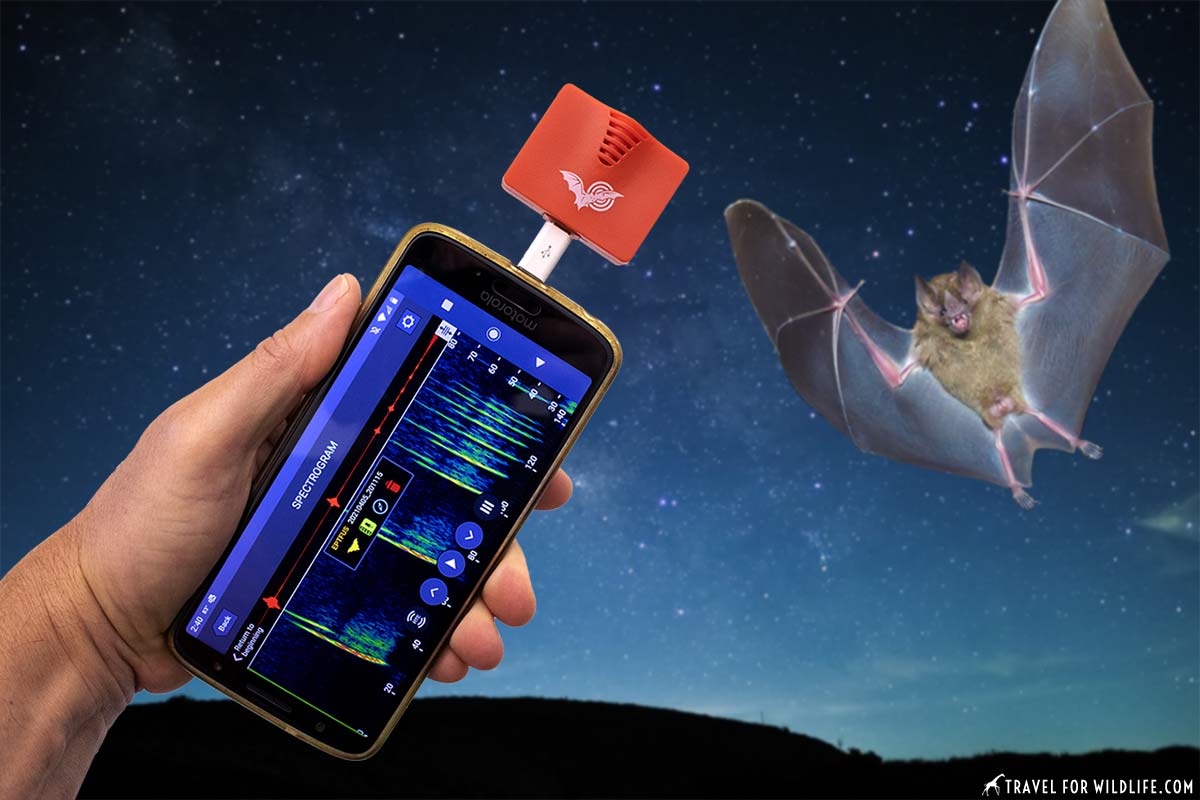
Bats have an incredible skill. They can use sonar to navigate in the dark and to catch tiny insects on the wing. They do this by “shouting” short chirps or clicks into the air and processing the echoes as they bounce back into their ears, known as echolocation. These sounds occur at a pitch that is higher than humans can hear so we refer to it as “ultrasonic”. But with an ultrasonic microphone and bat recorder, scientists can record and analyze the echolocation calls of different bat species, then learn to identify them by their call.
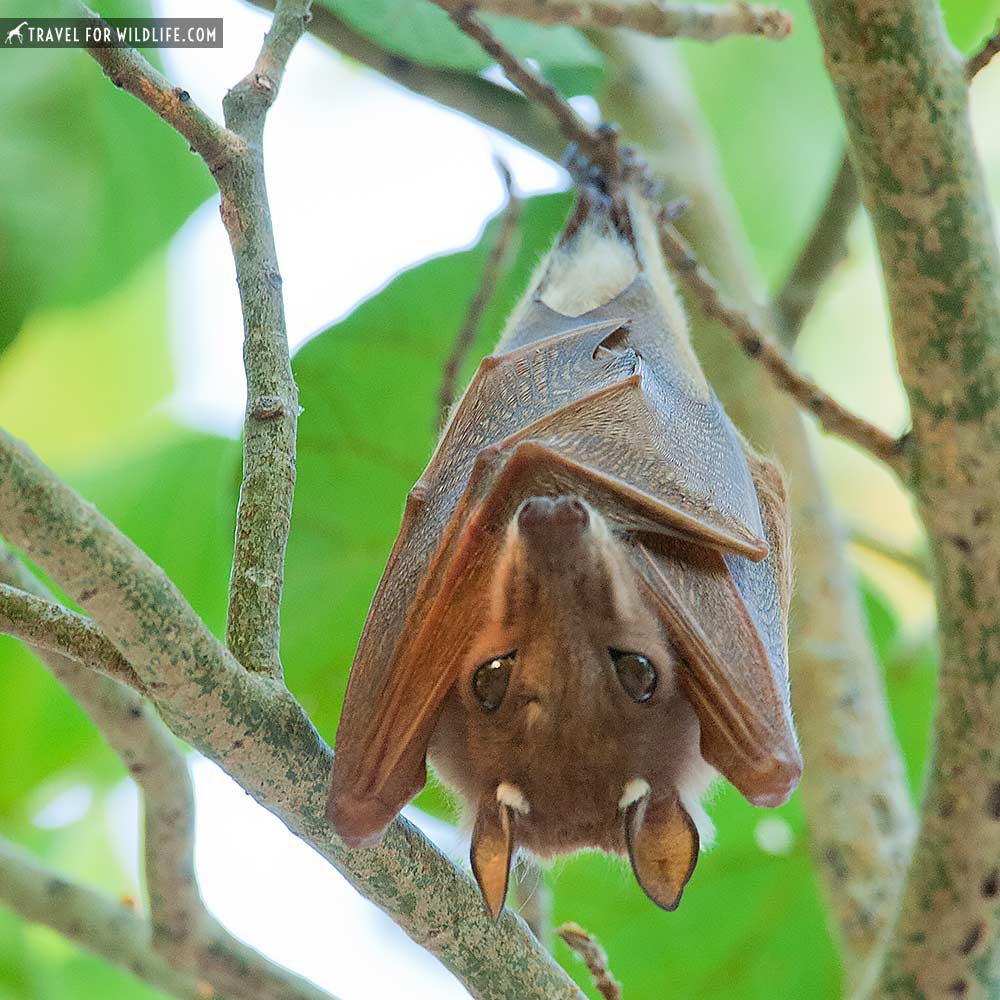
Video Review of the Echo Meter Touch 2
Take a look at our video review of the Echo Meter Touch 2 bat detector to see how it works!
*This article may contain affiliate links. We receive a small commission at no extra cost to you.*
Need a Bat book? Check out this Bats of the United States and Canada guide. After you’ve identified your bat, this is a great resource to learn about your batty neighbors.
What is the best bat detector?
After many days of research and wondering what would be the best bat detector for me, I came across a really cool bat detector kit that includes both an ultrasonic microphone and a bat detector app for my phone. So I got one for myself and tested it for a couple months. Now I’m convinced that the Wildlife Acoustics Echo Meter Touch 2 is the best bat detector on the market for both wildlife enthusiasts and for hand-held scientific field research. In a nutshell, it’s the most compact, powerful, easy-to-use, and affordable option out there.
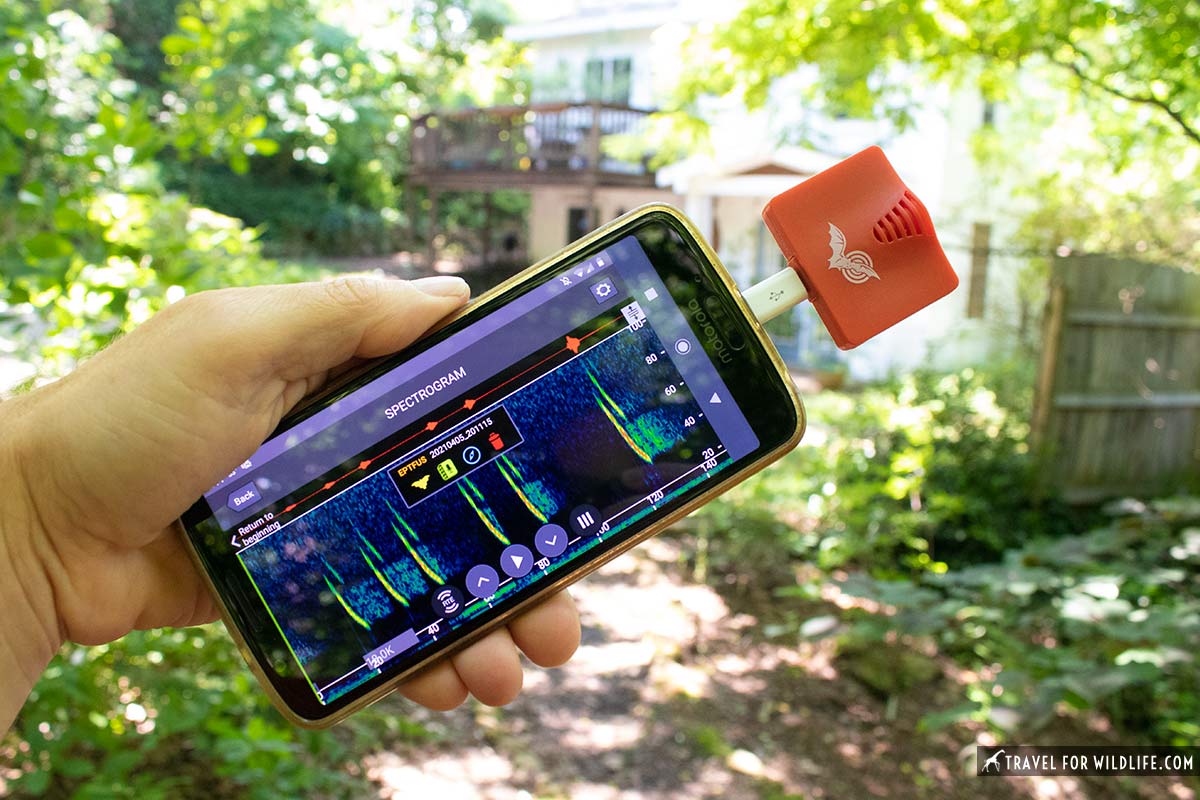
If you’re a regular person like me who wants to hear bat echolocation calls and learn what species are in your yard, then this is, without a doubt, the coolest wildlife gadget you’ll ever own. With a price tag of only $179 (at time of writing) it is well within the price range of most backyard wildlife enthusiasts. But don’t let the cheap price tag fool you. This little gizmo is packed with sophisticated technology and uses advanced scientific identification software to let you know who you’re listening to. I think it’s a fair price to pay for a super power.

And the best feature in my opinion: it’s tiny. Cristina and I travel frequently to look for wildlife. This little guy sits snuggly in my pocket in a cute little pouch and is ready for action as soon as the sun sets.
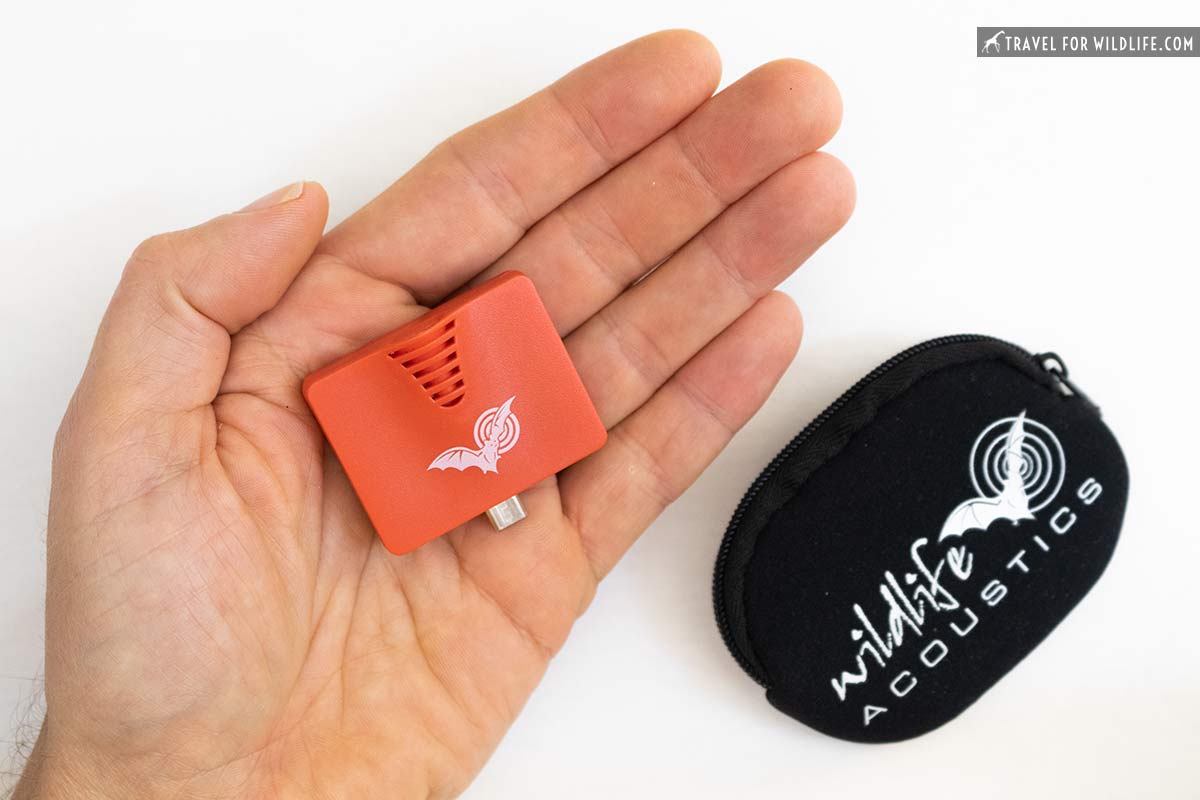
Is there a bat detector app?
Yep. Wildlife Acoustics has created their free bat detector app for both iOS and Android devices that works in conjunction with their Echo Meter Touch 2 (or Touch 2 Pro) ultrasonic microphone. Nope, the apps can’t detect bat sounds without the ultrasonic microphone module attached, but you can import and replay recordings from other devices without it.
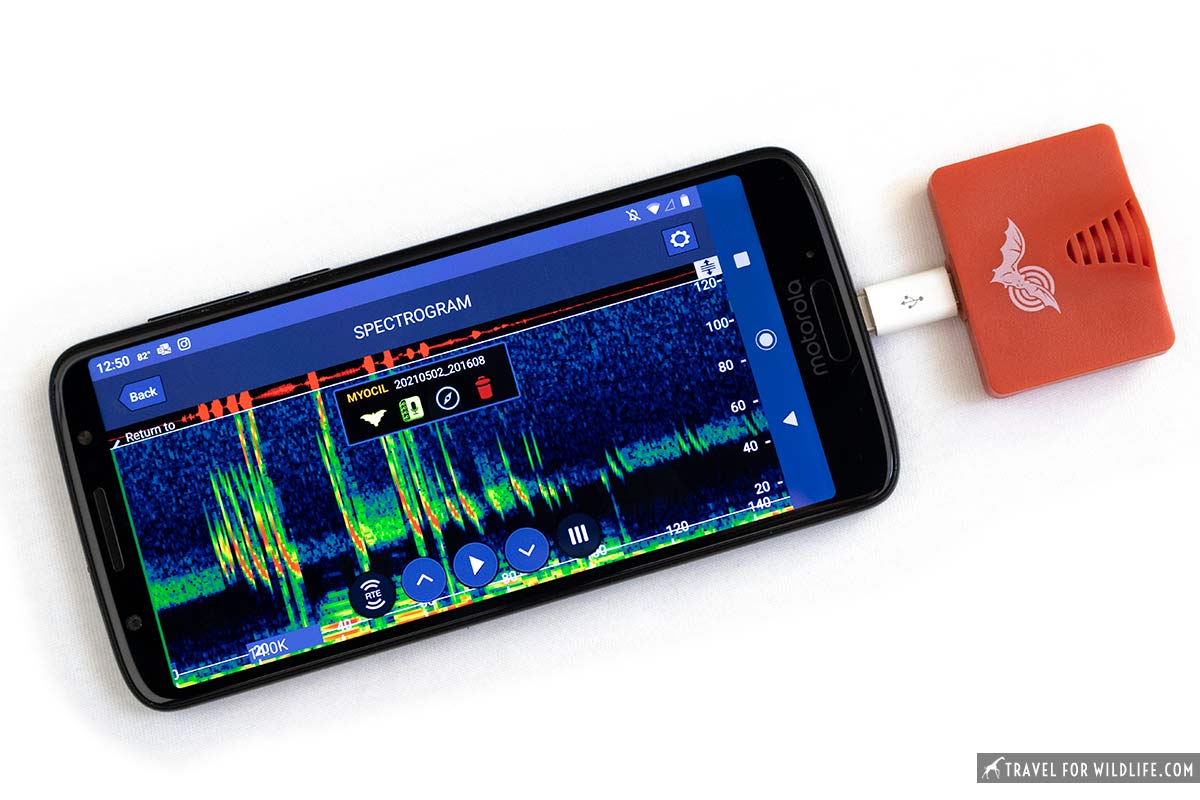
This bat detector app is packed with amazing features, but you don’t have to be an expert to use it. I was up and running in seconds, listening to bats, recording them, and identifying them without, I admit, ever reading the manual. Thankfully they have an excellent collection of tutorial videos and you only have to watch the quick start video to do most everything you’d ever want to do.
You can also download a free version of their Kaleidoscope analysis software and use it on your desktop or laptop (Mac, PC, or Linux) to view the spectrograms and listen to recordings of bats and other animals like birds and frogs.
iPhone bat detector vs bat detector for Android
Are you dreaming of an iPhone bat detector or perhaps an iPad bat detector? Then you better hurry.
According to a recent email, Apple has discontinued the lightning connector that Wildlife Acoustics uses to connect the Echo Meter Touch to Apple devices. They’ve already sold out the Echo Meter Touch 2 for iOS and expect to sell out of the Echo Meter Touch 2 Pro for iOS by the end of 2022. Hopefully they will find a new solution soon to continue providing an iPhone bat detector option. In the meantime the bat detector for Android is still available. However, I did just notice that the Android EMT 2 was “sold out for the season” while EMT2 Pro was still in stock at $349.
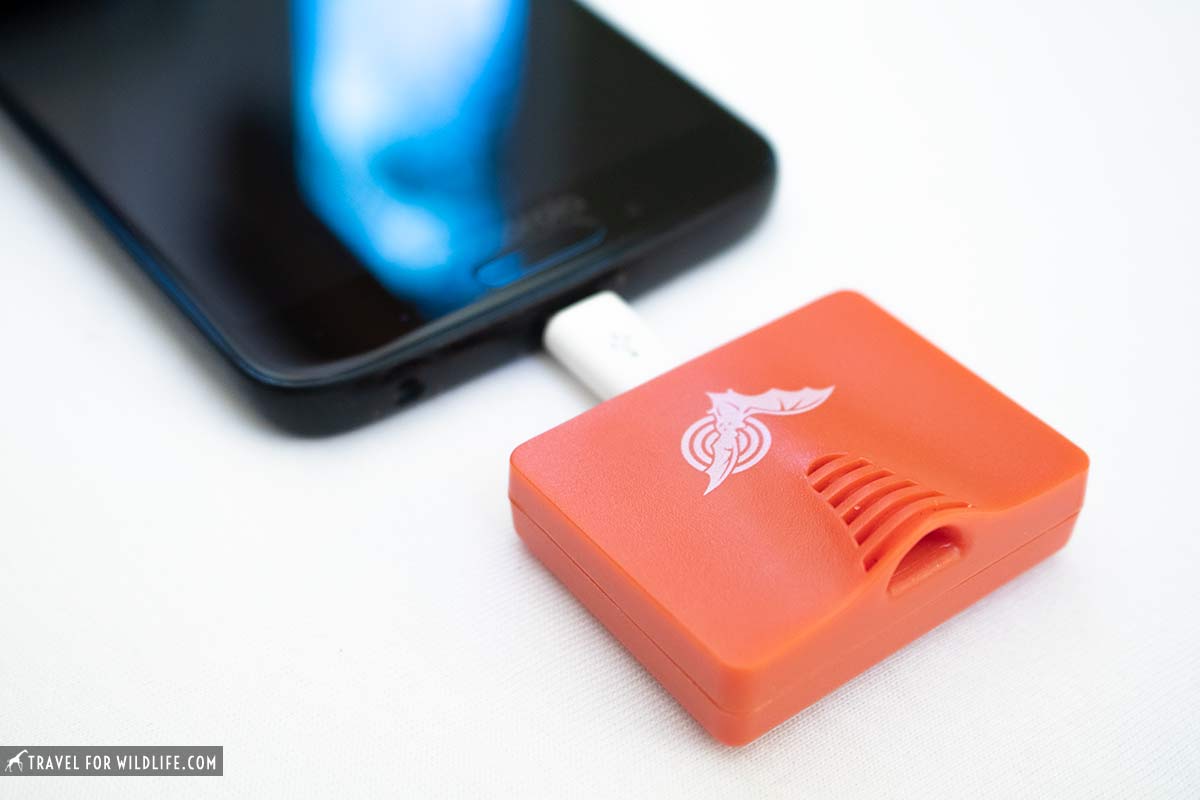
My personal experiences using the Echo Meter Touch 2 bat detector
I received the Echo Meter bat detector in late December. Oh wait, that’s not exactly true. I got it for Cristina for her birthday. But I would soon hijack her gift and use it obsessively almost every night.
(Full disclosure: I was given this bat detector in exchange for a review but all of the opinions in this article are entirely my own. Yep, I got Cristina’s birthday present for free and then mostly used it myself. Am I cheap or what?)
*This article may contain affiliate links. We receive a small commission at no extra cost to you.*
Who’s hibernating in our Bat House?
About 7 years ago I built a bat house and attached it to the side of our house. But it wasn’t until this winter that we started hearing funny little chirps and twitterings coming out of it. Upon closer examination we realized we finally had bats!
We built our bat house, but you don’t have to! You can get your bat house here. But if you want to build one yourself, this bat house guide will help you.
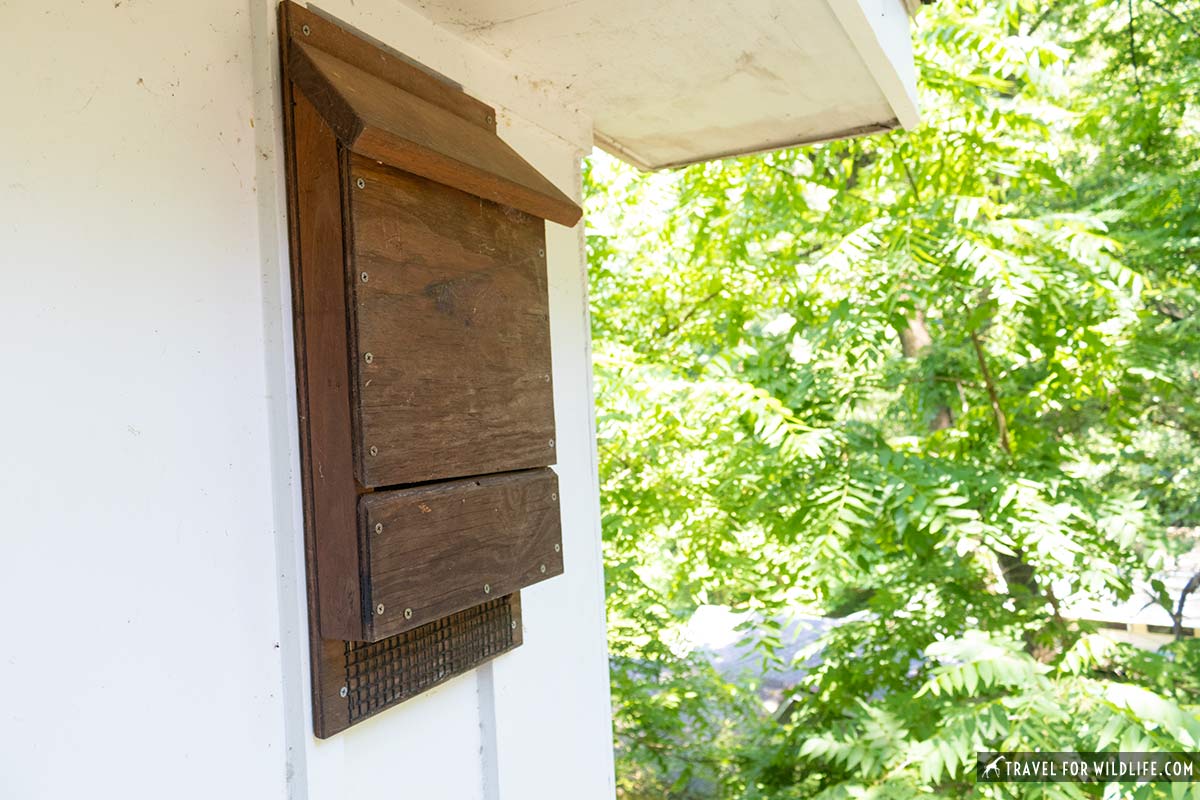
In our region (North Carolina mountains in the United States) bats hibernate in the winter because there are few insects around. But on warm days they may ‘wake up’ for short periods and became chatty with their neighbors. These social sounds are mostly within the range of human hearing. That’s what we could hear coming from the bat house.
I managed to get some photos of them with both my phone and a DSLR camera by carefully pointing them up through the bottom opening of the bat house. We had at least three and possibly four in there! But I had little confidence in my bat identification skills so I had no idea who our new friends were. That’s when we started searching for a bat detector.
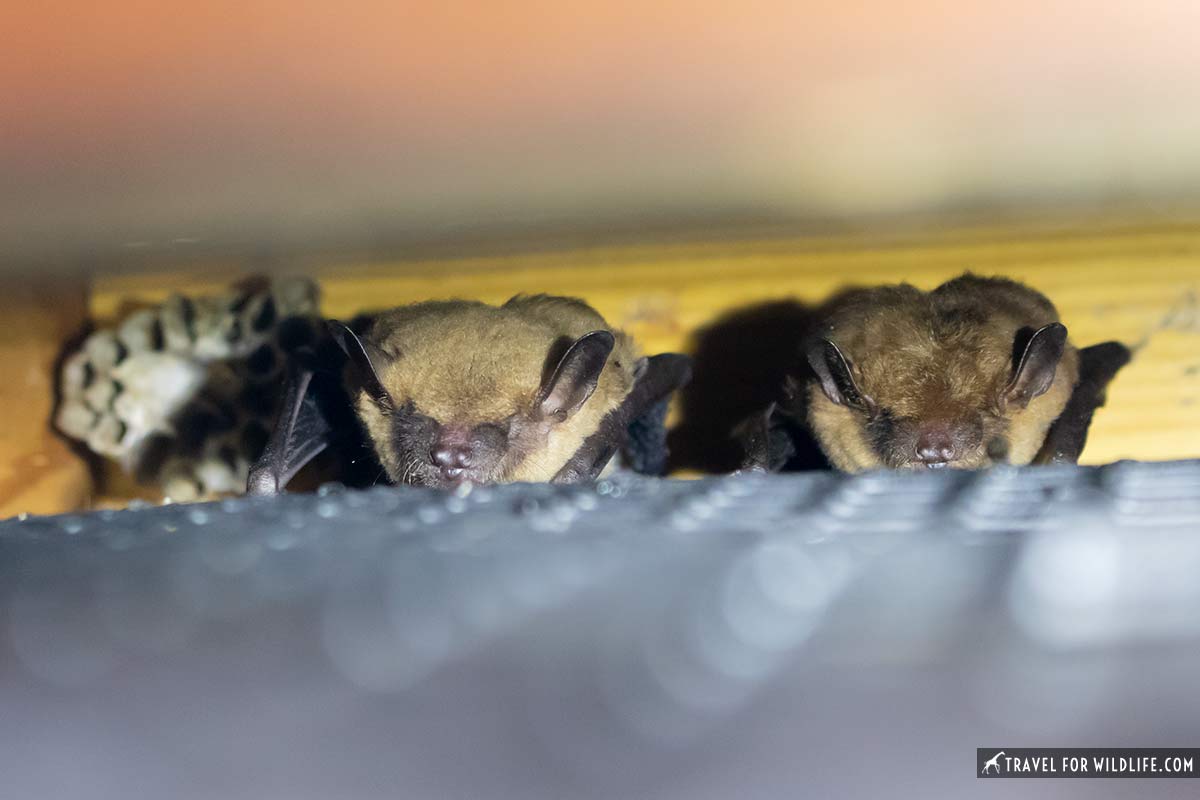
The problem is that a bat recorder like the Echo Meter Touch 2 identifies species using ultrasonic echolocation calls that are made while flying and hunting. And ours wouldn’t be flying for months until the insects returned. So we had to wait until the days got warmer before we could try it out.
When spring arrives, the bats start flying
In early April, when sunset temperatures were climbing steadily above 60 degrees, I started parking myself in a chair near the bat house while the sun went down. I placed the ultrasonic microphone module in the charge port of my phone (I use a pretty run-of-the-mill Android model) and started the app.
Because my charge port is on the bottom of my phone, I had to flip my phone over to point the microphone toward the bat house. Since apps can’t flip upside-down on my phone, I had to view the screen sideways in order to watch the color spectrogram rolling by. I selected North Carolina from the Auto ID Selection menu so it would only choose species likely to be in my area, and I chose the RTE setting for audio (Real Time Expansion) so I could listen to the pulses in real time. Then I turned up the volume on my phone and listened.
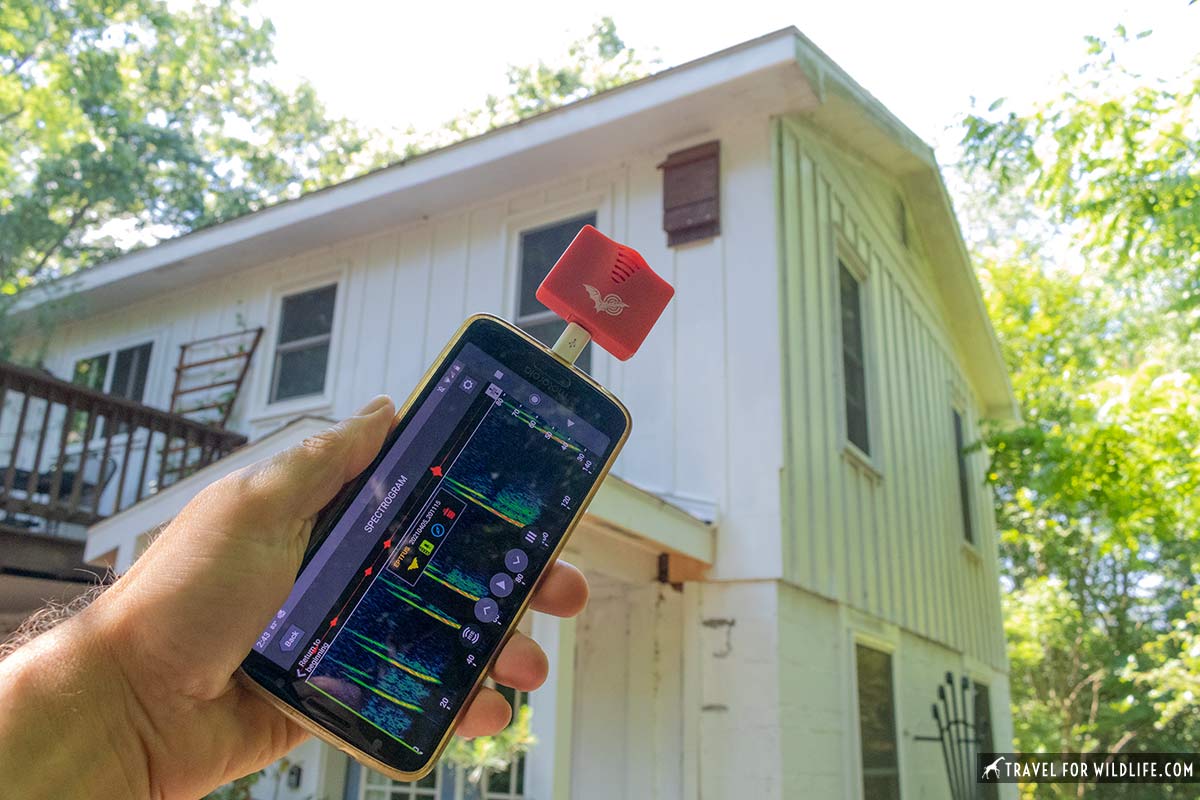
The spring peepers were calling loudly from our pond, but hearing their high pitched calls through the app came out only as very low thuds. Then, 15 minutes after the official time of sunset, I heard it. Not with my ears but through the phone.
A series of sharp, descending chirps, repeated in clusters. Someone was preparing to exit the box! I hit the manual recording button (which starts recording 5 seconds in the past so you don’t miss anything) and looked up. The chirps became louder and faster and then, right before my eyes, a bat descended from the box and swooped up over my head into the gloomy dusk. Woo hoo!
To my ears the bat had been totally silent, but through the app I could tell she was echolocating like crazy as she left the house and, in reality, was shouting quite loudly! I was thrilled and smiling from ear to ear.
The moment I had been waiting for: my bat identification
I hit stop on the recording and a second later a box popped up on the screen. It was the moment I had been waiting for, the most likely match for the species I had just recorded. “Big brown bat” it said. Eptesicus fuscus.
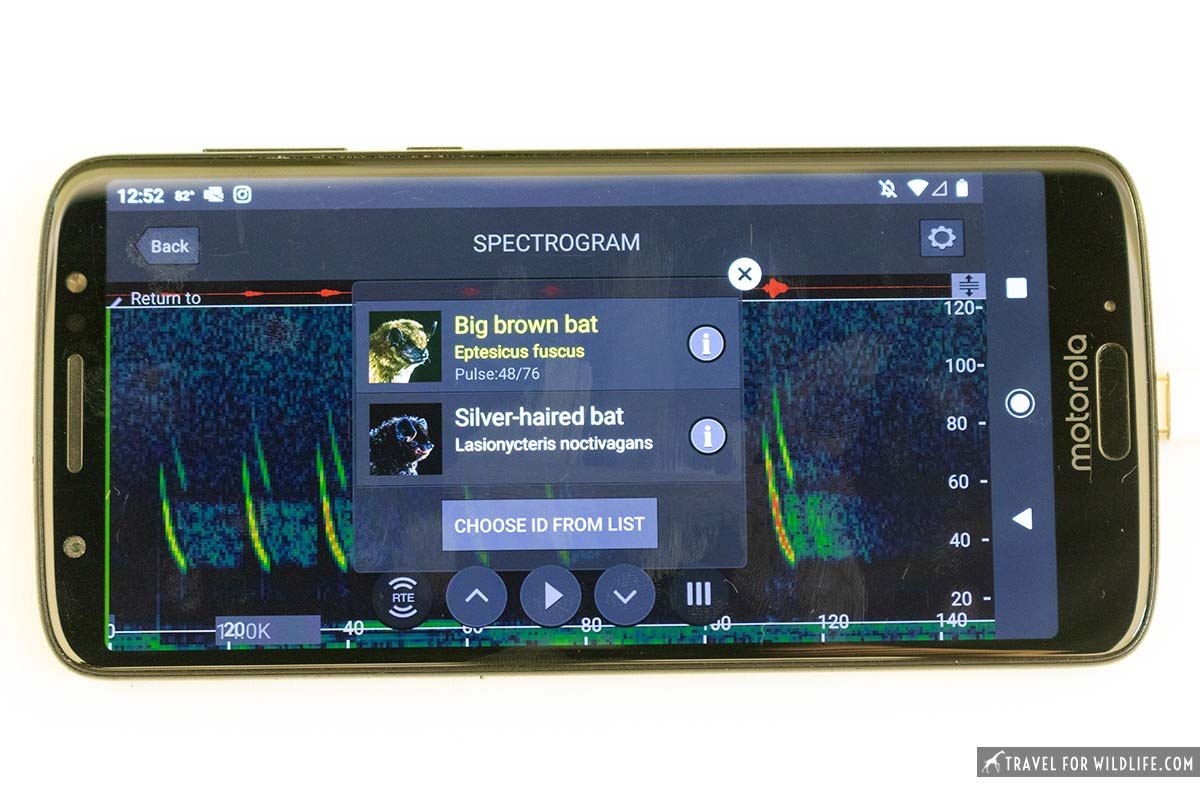
When I tapped the info button, a portrait of the creature filled my screen. She had shaggy reddish brown fur coming down a deep forehead to an otter-like nose and a wide smile. Large black ears protruded above her twinkling eyes. There you are, my little friend. Nice to meet you!
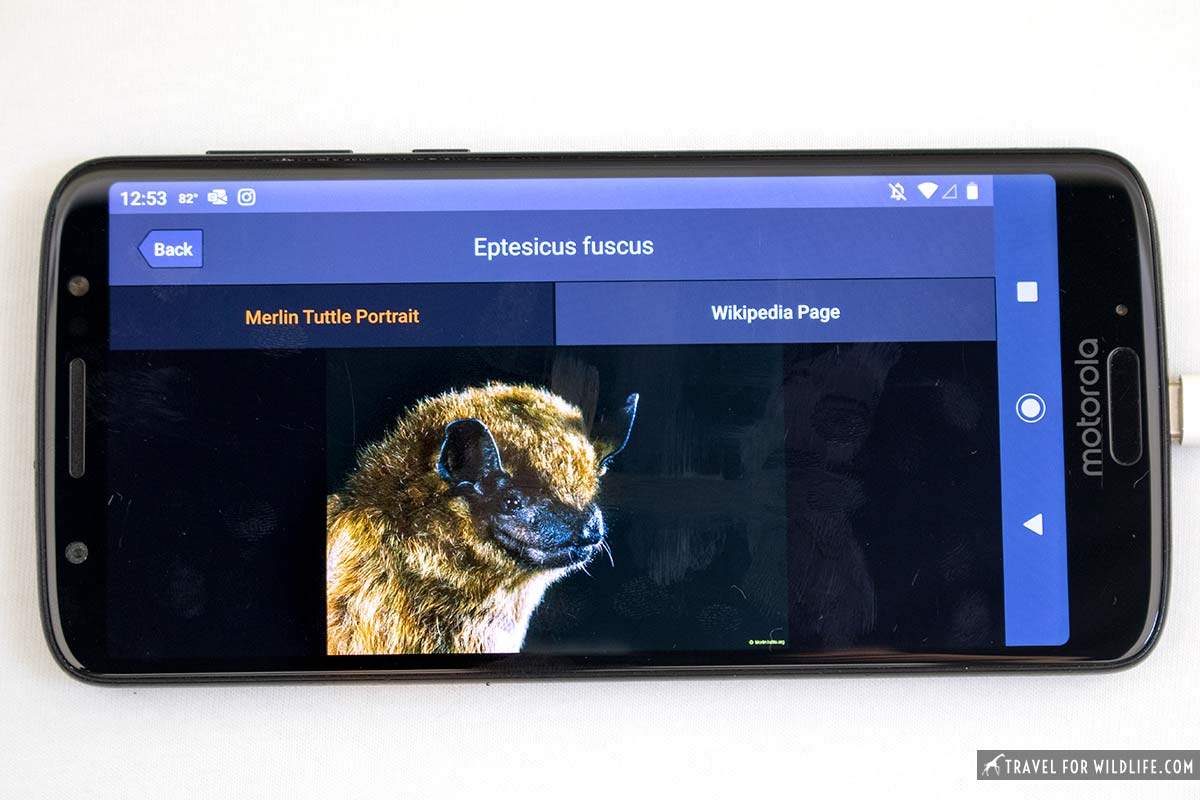
Another tab took me to the wikipedia page for the species. There I learned that the big brown bat, as the name implies, is pretty big for a microbat, with a wingspan of more than 12 inches! I also learned that the big brown bat thankfully appears to be somewhat resistant to the effects of the devastating white-nose syndrome that is wiping out bat populations across the United States.
For many nights I recorded the bats leaving their bat house. Every time I received the same ID so I felt pretty confident in the accuracy of the identification. (See later section: How accurate are bat identifications?). But it was the only species I could find near my house. I wanted to try it out in other locations and start building my species list!
Detecting bats across the United States
First we took a quick jaunt to Cedar Key in Florida, where I tried it out on the quiet roads near the Faraway Inn. At sunset we immediately started spotting bats and my bat recorder identified them as evening bats! (Nycticeius humeralis). I could see how different the pulses were from my local big brown bats by studying the shapes on the spectrogram.
In early May when I had finally completed my Covid vaccination shots my mom and I did a cross-country road trip from NC to California and back for my nephew’s wedding. I tried it at Juniper Campground in Bandelier National Monument in New Mexico. The first two identifications gave me northern long-eared myotis (Myotis septentrionalis) and my next seven came up as western small-footed bats (Myotis ciliolabrum) so either I had two species flying through or, more likely, the first 2 recordings were mis-identifications.
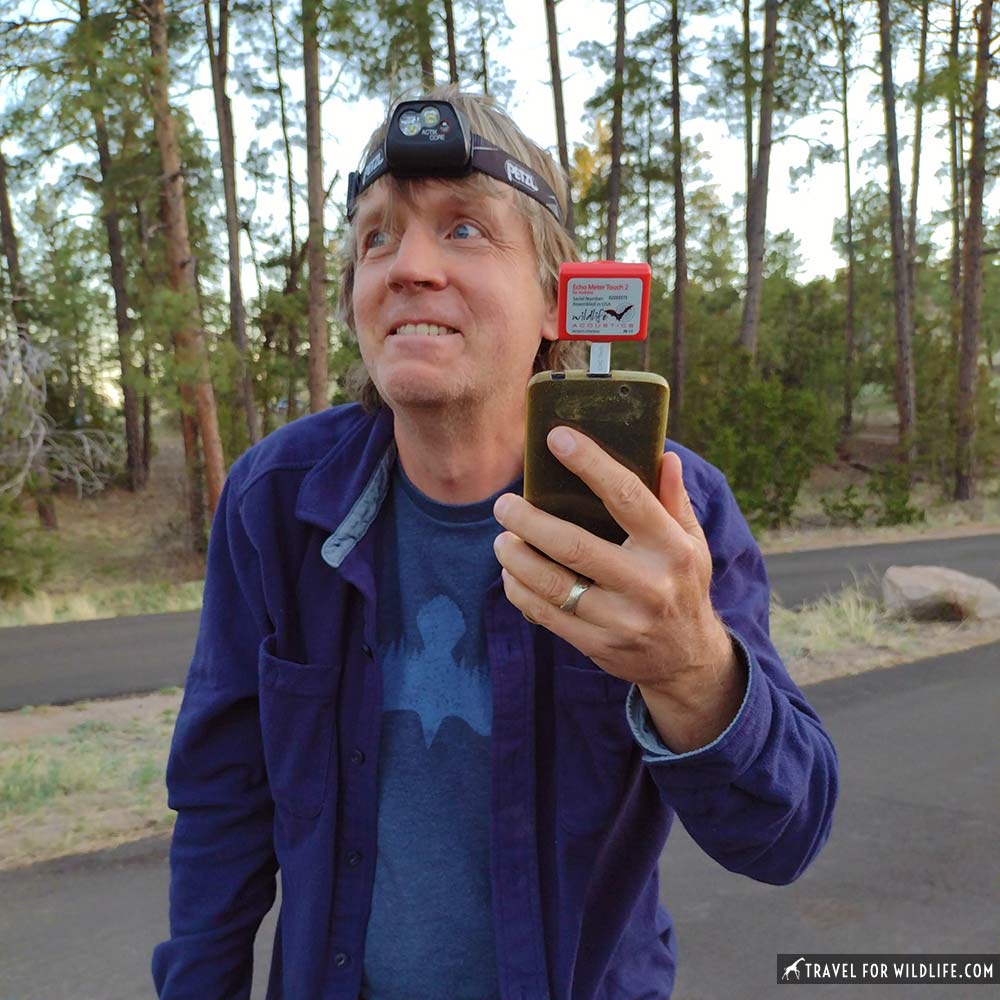
In Barstow, California I picked up western pipistrelle (Parastrellus hesperus) from a Super 8 parking lot. Cool!
In late May we made a run to Tennessee to see the glow worm caves in Pickett State Park. While staying in one of the adorable stone cabins built by the CCC, I detected a silver-haired bat (Lasionycteris noctivagans) flying nearby.
And then in early June on a quick trip to Raleigh, NC I had a mysterious clump of five different identifications in one 10-minute period. Here is my list of ID’s followed by the accuracy rating (Correct Classification Rate) for each species according to the Classifier Performance Table.
- 1 Mexican Free-tailed Bat (Tadarida brasiliensis) 52% accuracy
- 1 Silver-haired Bat (Lasionycteris noctivagans) 69% accuracy
- 1 Hoary Bat (Lasiurus cinereus) 53% accuracy
- 1 Northern Yellow Bat (Lasiurus intermedius) 50% accuracy
- 3 Seminole Bat (Lasiurus seminolus) 28% accuracy
Based on the accuracy rates, I concluded that it was simply my first experience with a species that was difficult to identify. In retrospect I should have turned the Auto ID Sensitivity setting from Sensitive to Accurate and might have had better luck getting the right ID. (See the section How accurate are the bat identifications? below)
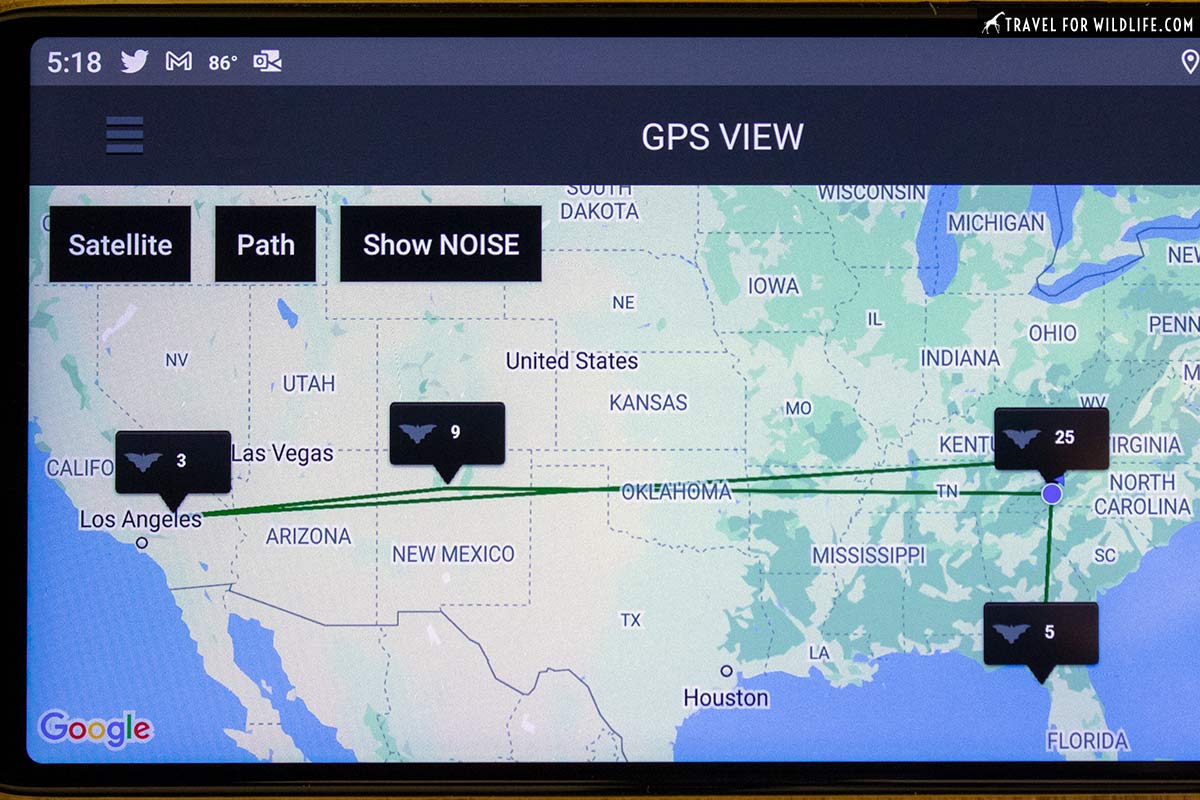
Bat Identification Guides
These guides are very useful as it gives you visual cues on how to identify bats for when you are watching bats. We use the Bats of eastern North America: a comprehensive guide to all species, and you can also get the Bats of western North America: a comprehensive guide to all species.
How a bat detector can tell what type of bat is flying?
There are more than 1,400 species of bats in the world with more than 40 here in the United States. So how can a bat detector tell what type of bat is flying overhead? Through a combination of solid scientific research, lots of ultrasonic recordings of bat echolocations, and some high tech digital analysis. Using complex, proprietary algorithms, Wildlife Acoustics researchers create “classifiers” to match the most likely species to a recording of a bat’s echolocation pulses.

Wildlife Acoustics is a big name in the world of wildlife audio research and they’ve built some of the most advanced wildlife sound identification software available. One of Wildlife Acoustics software products is called Kaleidoscope Pro Bat Auto ID. They’ve developed classifiers for 38 bat species in North America, which covers almost every species you’re likely to hear. But they’re also constantly adding to their list of classifiers for other regions of the world. At the time of writing they created classifiers for 37 species in the UK & Europe, 37 Neotropical species, and 21 in South Africa. You can see a complete list of species here.
But the best news is that the Echo Meter Touch 2 uses the exact same database of classifiers in its free app. Though the website says new classifiers may lag a couple weeks behind the Kaleidoscope software so be sure to keep your app updated.
My favorite flying bat photo I’ve ever taken (below) is of a Jamaican fruit-eating bat (Artibeus jamaicensis) which is one of the only fruit-eating bats that occur in the United States (found only in the Florida Keys). But ironically, it is also one of the only species that Kaleidoscope doesn’t yet have a classifier for in the North American list. Even though it’s a fruit eater, it still uses echolocation. Previously thought to be a “whispering bat” it has since been proven that their echolocations are extremely loud! I photographed this one under a Maya ruin in Tikal, Guatemala.
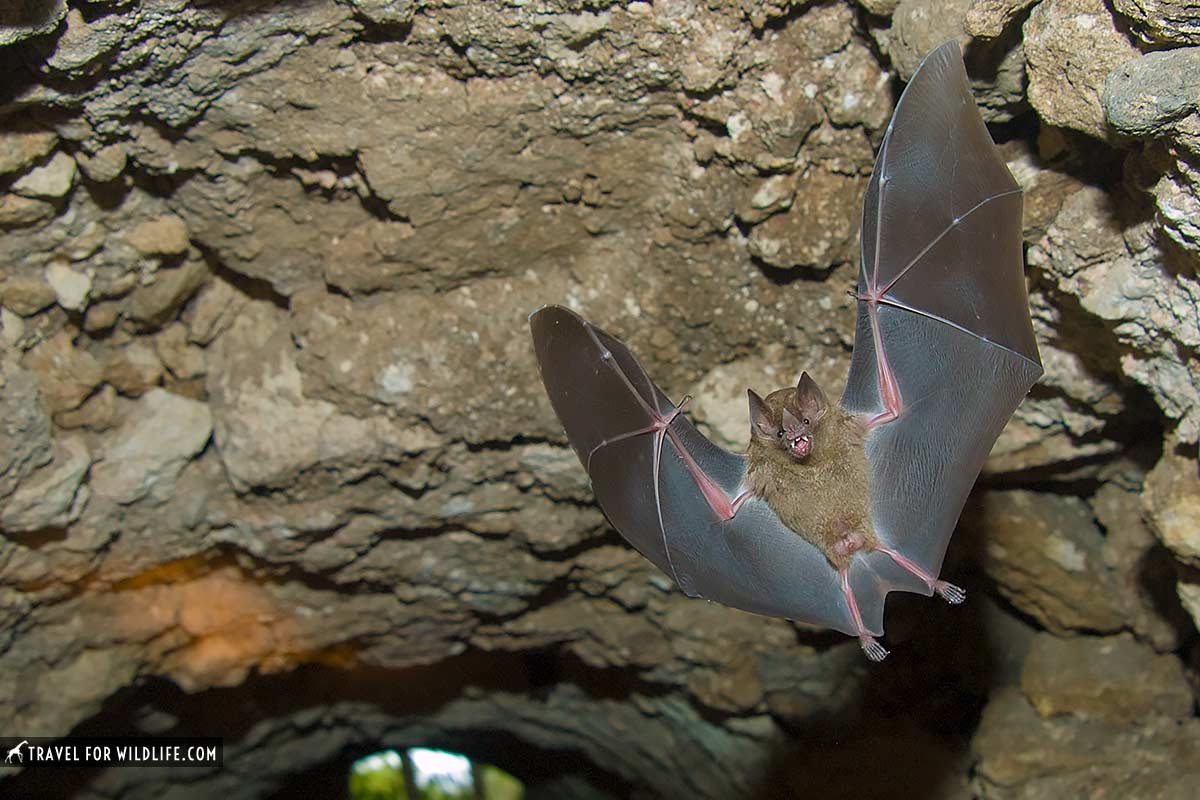
We’re excited to try our bat detector in South Africa because we travel there often. In the photo below you can see a bat flying over Cristina’s head in a chalet in Twee Rivieren in the Kgalagadi Transfrontier Park, South Africa. Next time we’ll identify what species they are!
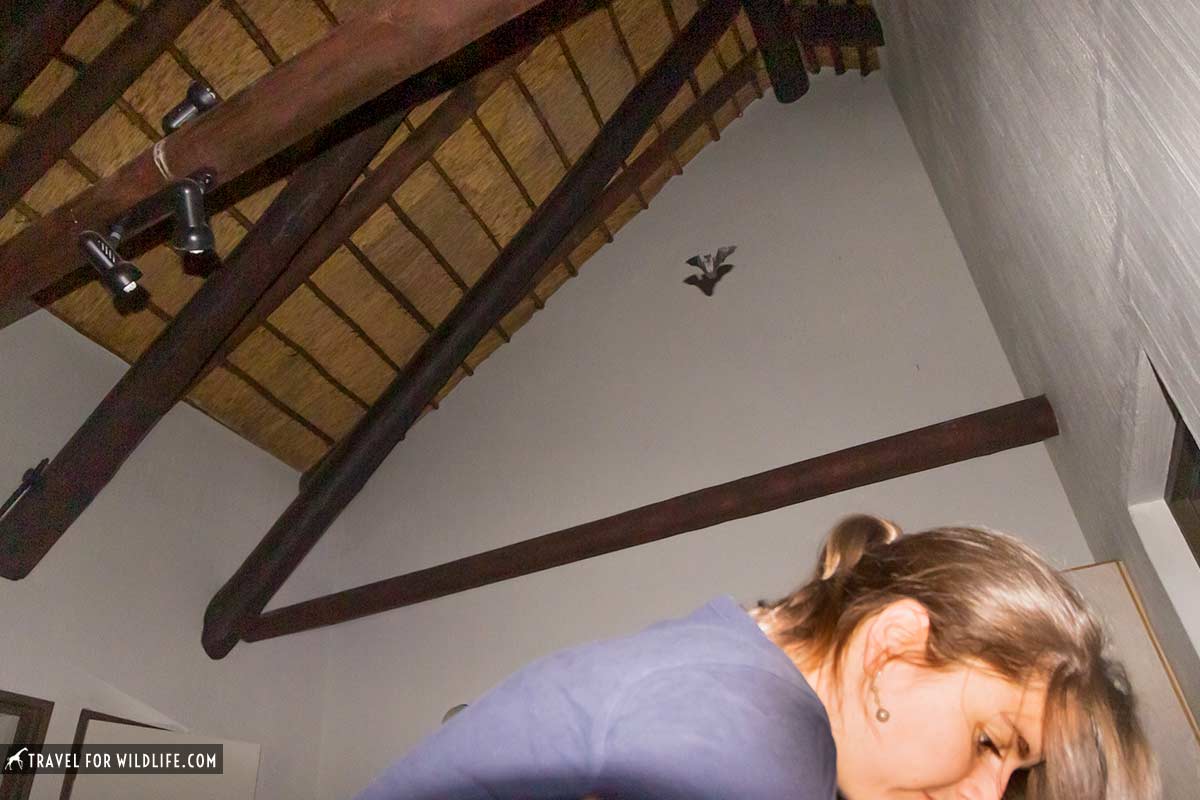
How accurate are the bat identifications?
So just how accurate are the identifications given by this bat detector kit? The short answer is you get an accurate ID about 80% of the time. But the more complete answer is that it depends on two factors: the species and the Auto ID Sensitivity setting you use during recording.
If you set it to “Sensitive” then you’ll get more identifications but they’ll be less likely to be accurate. Conversely, if you use the “Accurate” setting you’ll get fewer ID’s but you’ll have a much higher accuracy rate. If you want something in between you can choose “Balanced”.
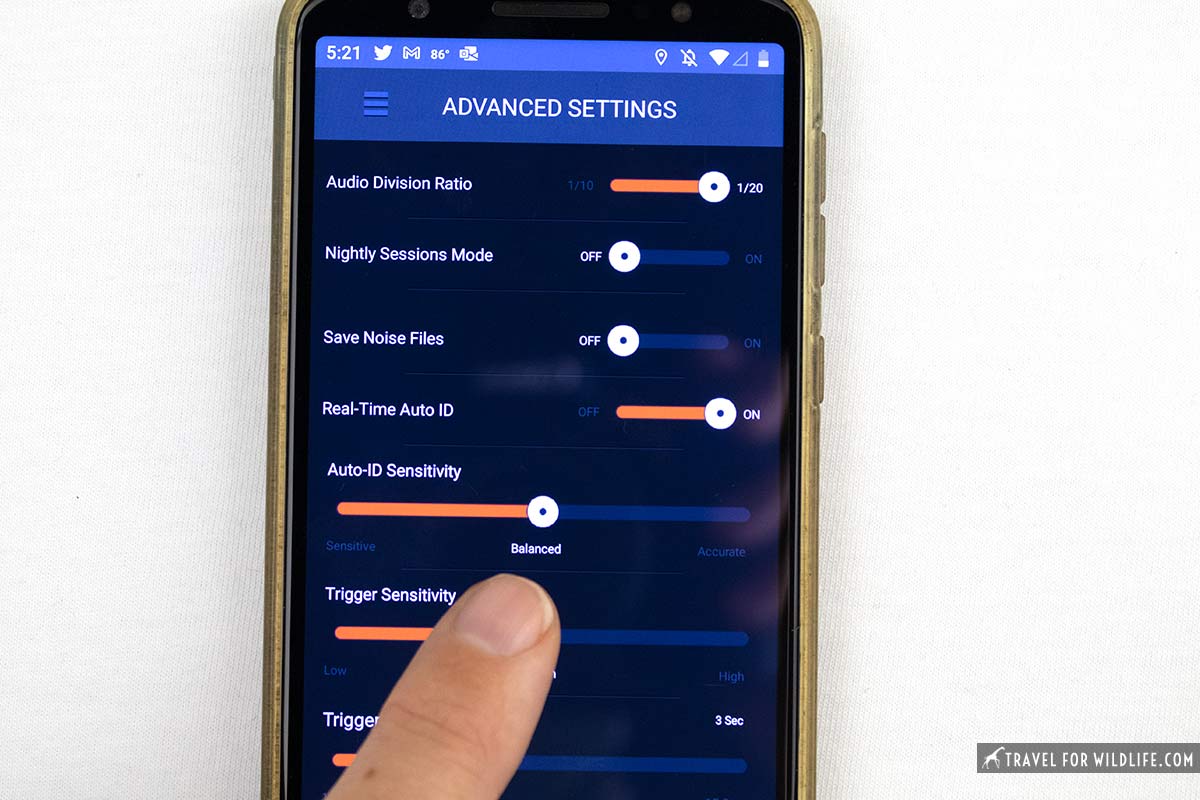
Let’s use North America as an example. Based on the most recent Classifier Performance Table we can see that using the “Sensitive” setting you’ll receive an accurate ID about 70% of the time on average. However, some species tend to get confused more easily, while others have more distinct echolocation calls. You’ll get an accurate ID about 97% of the time if it’s a Spotted Bat (Euderma maculatum) and only 31% of the time if it’s a Cave Myotis (Myotis velifer).
If you use the “Accurate” setting on the app, you’ll end up with fewer recordings getting an ID, but they’re more likely to be accurate when you do. Now you’ll have an average 82% success ratio of correct ID’s, with several species reaching 100% accuracy.
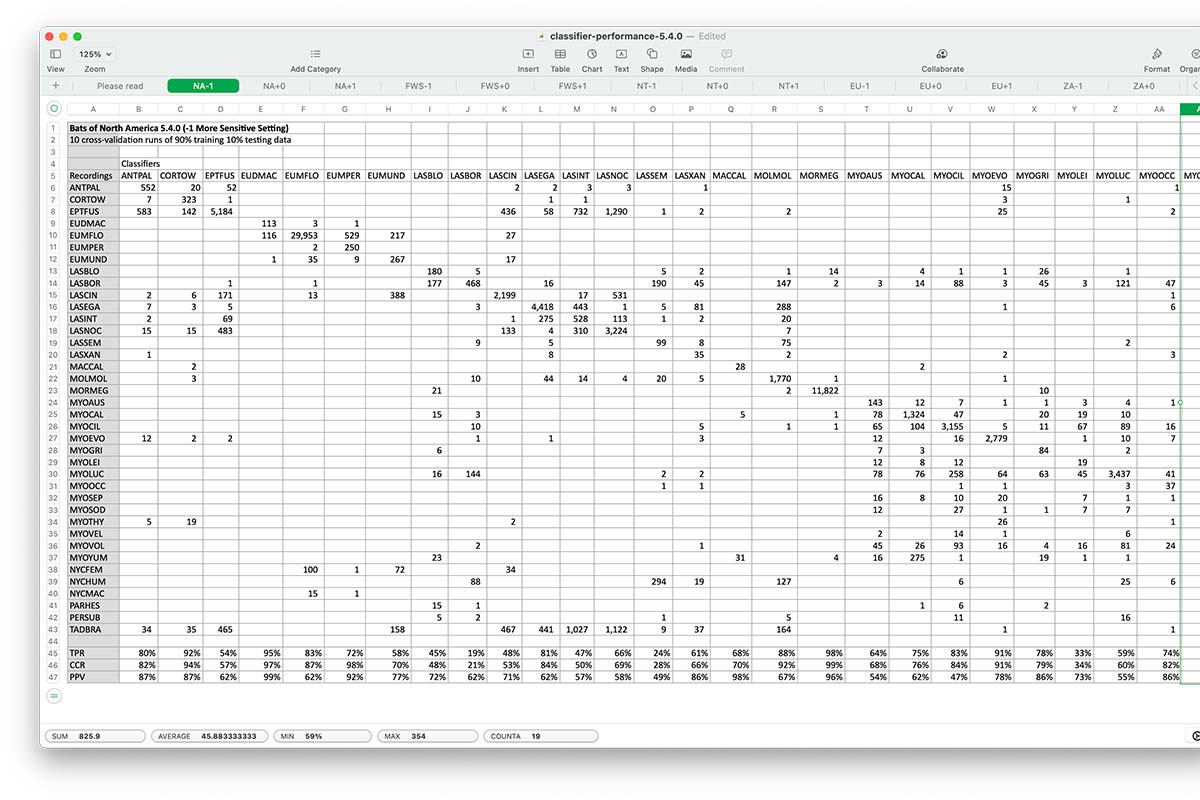
Keep in mind that the identification software won’t work as well in cluttered spaces (like forests) or when multiple bats are flying overhead. You’ll get the most accurate ID results from a single bat flying over in a more open space.
Other cool things you can do with the Echo Meter Touch 2 Bat Recorder
Auto Recording
You can simply hit the record button and Echo Meter Touch 2 will automatically record whenever a bat echolocation is detected! You can choose parameters for recordings to suit your needs.
Share files
It’s really simple to export .wav files to your computer or share them with others. You can email them, text them, airdrop them, etc. or transfer them to your desktop via wifi. You can install the free Kaleidoscope Lite analysis software on your computer to view and analyze your transferred recordings!
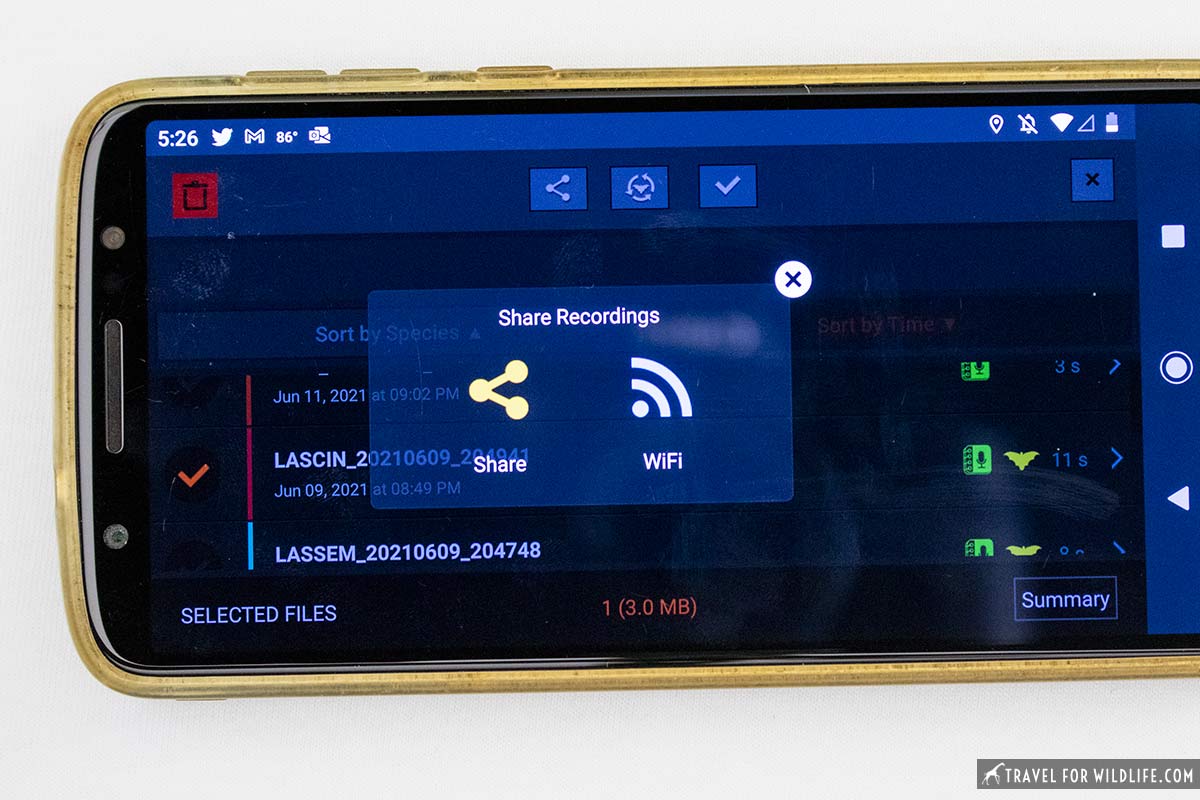
GPS view
If your phone or tablet is GPS enabled, the Echo Meter Touch 2 records GPS data for each recording and embeds it in the metadata for that file. In the app you can look at a GPS view to see where all your recordings were made and follow the path you used between recordings!
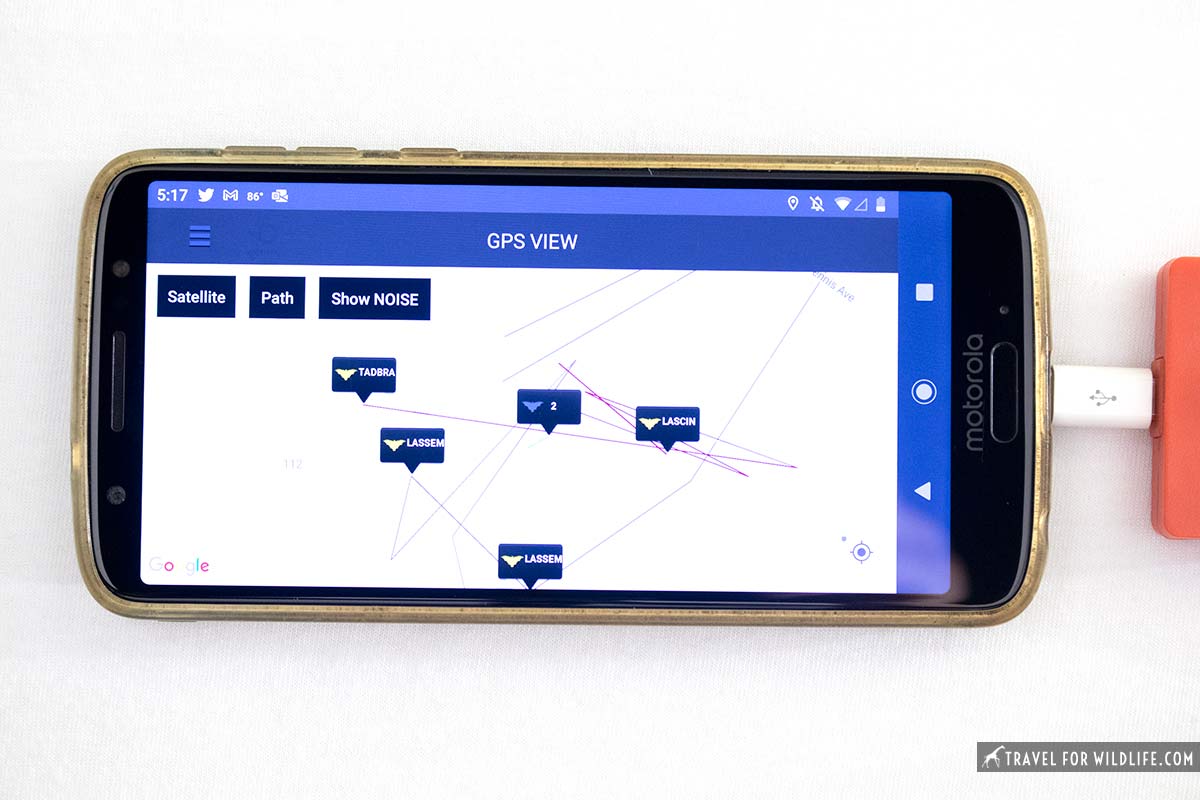
Label recordings with text and voice notes
It’s easy to add a note to a recording by typing it or simply recording your voice. I use it to add info about where I recorded it like “Super 8, Barstow, CA”.
Choose different listening modes
I prefer to use the RTE (real time expansion) mode when listening to bats. This basically interprets the sounds into the human range of hearing in real time. You can also choose HET (heterodyne) which is a more old-school way of listening to bat echolocations and I have no clue how to explain it, but it just kind of sounds like clicks.
Finally, when you’re playing back saved recordings, you can use TE (time expansion) which may be the coolest one of all. It basically slows down the recording to one-tenth speed or one-twentieth speed (your choice) which brings it down into the human range of hearing. This way you can really hear the nuances of each pulse, the variations in pitch and speed, and it has an other-worldly haunting sound, sort of like the recordings of whale songs!
And since you made it through that boring section, here’s a cool picture of a bat crossing sign from Calakmul in Mexico! (from my animal crossing signs collection.)
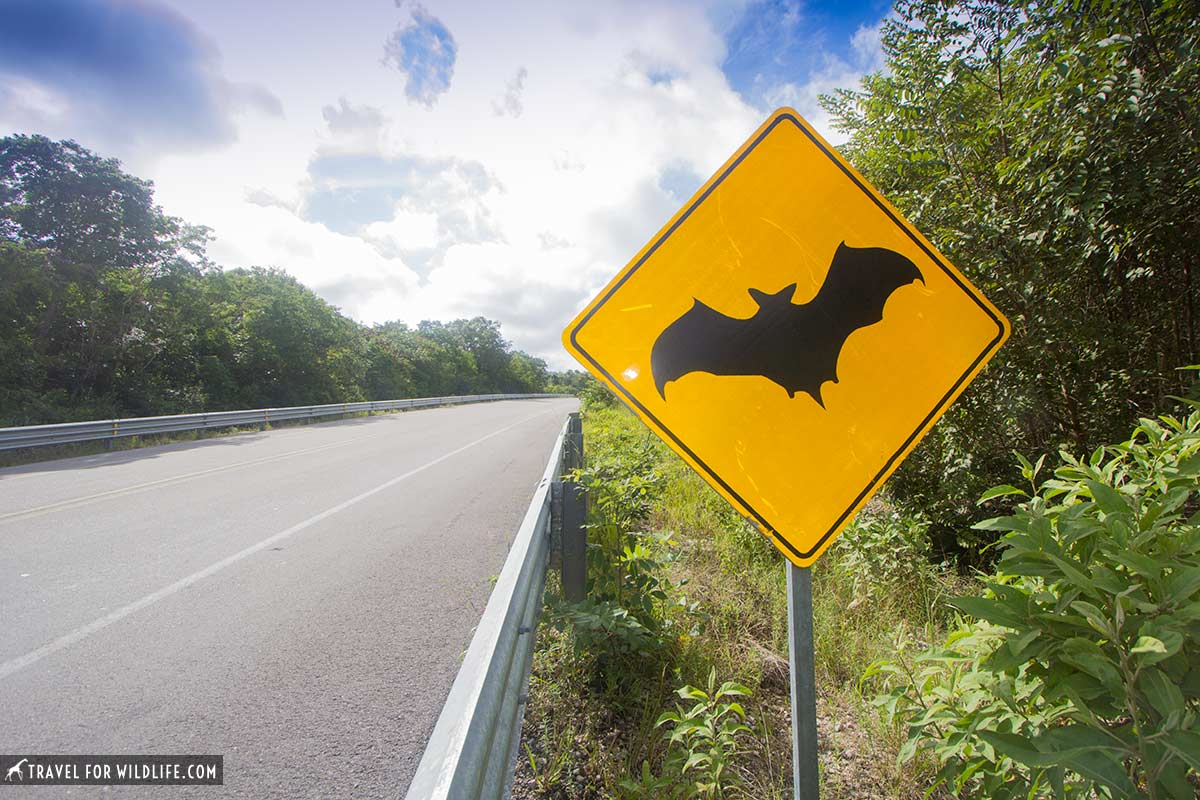
What else can you hear with a bat detector?
Just last night I started noticing ultrasonic cricket calls showing up on my spectrogram. It was really fun to play back the recording with time expansion set to 1/10th speed. Then I could actually hear every single chirp in the continuous “stridulation” of a cricket.
I also noticed on the Wildlife Acoustics FAQ page that the Echo Meter Touch 2 can be used to record ultrasonic mice vocalizations! But you’ll have to adjust a few settings to use it on species other than bats.
If you want to record bird and frog calls then check out the Song Meter Micro. It’s a standalone unit used to record wildlife calls and then you can view and analyze them with the Kaleidoscope software and even create your own classifiers!
In conclusion…
Now every night at sunset I find myself thinking “Ooh! It’s bat time!” and I want to get out and listen to our furry flying friends. Bats perform a critical role in our ecosystems, pollinating plants & controlling insect populations. It’s more important than ever for humans to connect with bats on a personal level, as white-nose syndrome is wiping out populations across North America. Get to know your flying neighbors, learn what they need to survive and try to provide it for them. And together we can help these wonderful animals when they need it most.
Check out the Echo Meter Touch 2 for Android and the Echo Meter Touch 2 Pro for iOS.
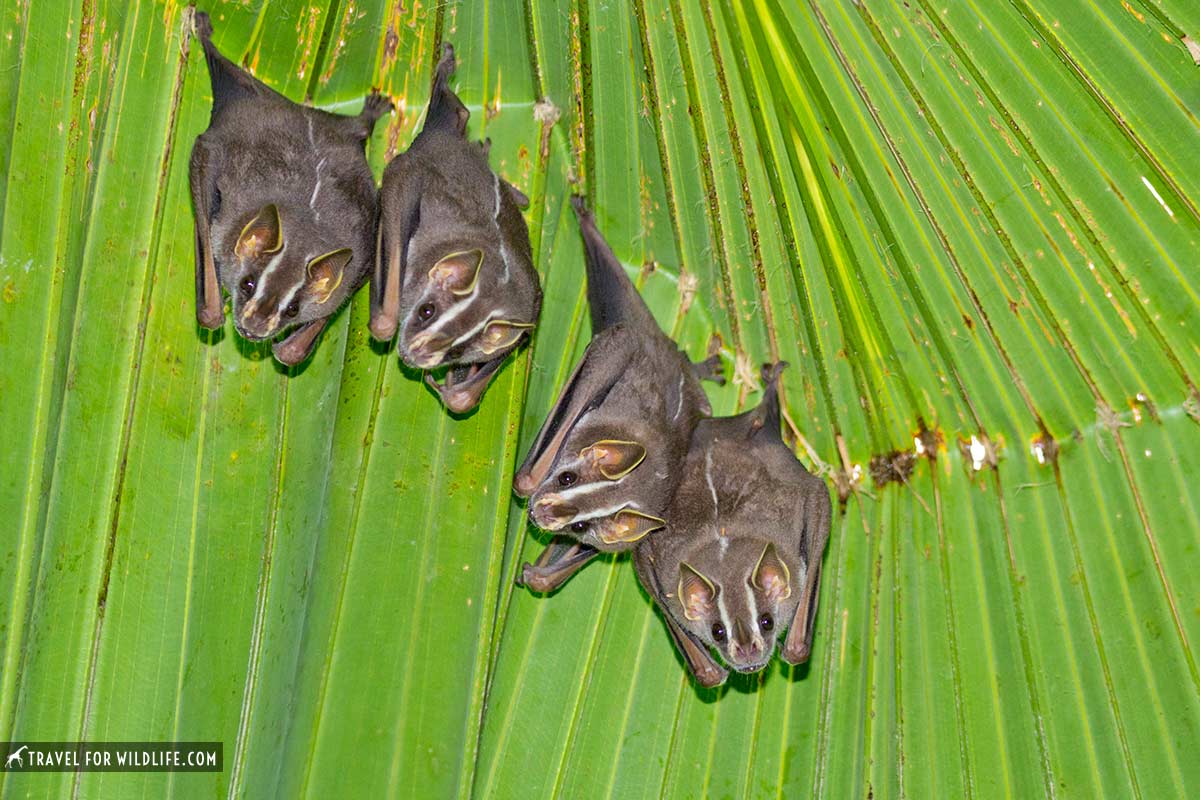
(P.S. Here’s a video we made of how to find tent-making bats in Costa Rica!)

Hal Brindley
Brindley is an American conservation biologist, wildlife photographer, filmmaker, writer, and illustrator living in Asheville, NC. He studied black-footed cats in Namibia for his master’s research, has traveled to all seven continents, and loves native plant gardening. See more of his work at Travel for Wildlife, Truly Wild, Our Wild Yard, & Naturalist Studio.

thewildside
Wednesday 8th of September 2021
Hi
Best ever beautifully described about the wildlife destinations . Its very attractive for tourists , while reading the blogs it was amazing , I hearty appreciate this article . Please update more news about wildlife and wild tours
Simon Pierce
Tuesday 15th of June 2021
Very cool! That looks amazing. I need it.
Hal Brindley
Tuesday 15th of June 2021
Ha! It's freakin awesome for sure. Hope you get a hold of one!